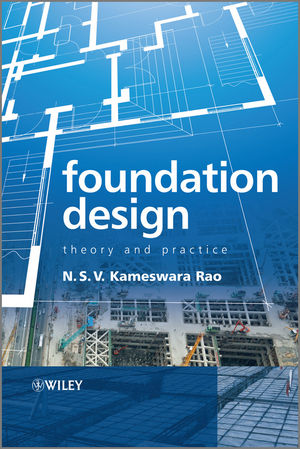Foundation Design: Theory and PracticeISBN: 978-0-470-82534-1
Hardcover
544 pages
February 2011
 This is a Print-on-Demand title. It will be printed specifically to fill your order. Please allow an additional 10-15 days delivery time. The book is not returnable.
|
||||||
Preface xix
Acknowledgments xxi
1 Introduction 1
2 Engineering Properties of Soil 9
2.1 Introduction 9
2.2 Basic Soil Relations 9
2.3 Soil Classification 15
2.4 Permeability 15
2.5 Over Consolidation Ratio 16
2.6 Relative Density 18
2.7 Terzaghi’s Effective Stress Principle 19
2.8 Compaction of Soils 20
2.9 Consolidation and Compressibility 21
2.9.1 Compressibility Characteristics and Settlement of Soils 22
2.9.2 Time Rate of Consolidation 24
2.10 Shear Strength of Soils 26
2.11 Soil Exploration and Sampling 32
2.12 Site Investigation -- Boring, Sampling and Testing 33
2.13 Split Spoon Sampler and Standard Penetration Test 35
2.14 Cone Penetration Test 39
2.15 Field Vane Shear Test 43
2.16 Other In Situ Tests 43
2.17 Summary 43
2.18 Examples 43
3 Bearing Capacity, Settlement, Stresses and Lateral Pressures in Soils 49
3.1 Introduction 49
3.2 Ultimate Bearing Capacity of Shallow Foundations 51
3.3 Bearing Capacity of Deep Foundations 57
3.4 Correlation of UBC and ASP with SPT Values and CPT Values 59
3.5 UBC and Probable Settlements Using Field Plate Load Test 62
3.6 Elastic Stress and Displacement Distribution in Soils 65
3.7 Settlement Analysis 72
3.8 Lateral Earth Pressure 74
3.9 Coefficient of Earth Pressure at Rest 86
3.10 Other Theories of Lateral Pressure 86
3.11 Examples 87
4 Rational Design of Shallow Foundations 119
4.1 Introduction 119
4.2 Shallow Foundations 120
4.3 Conventional Design and Rational Design 121
4.4 Procedures for the Design of Footings 122
4.5 Conventional Structural Design of Footings 136
4.6 Foundations in Difficult Soil Formations 137
4.7 Modeling Soil Structure Interactions for Rational Design of Foundations 140
4.8 Evaluation of Spring Constant in Winkler’s Soil Model 151
4.9 Soil-Structure Interaction Equations 162
4.10 Summary 163
5 Analysis of Footings on Elastic Foundations 165
5.1 Introduction 165
5.2 Literature Review 165
5.3 Analysis of BEF 167
5.4 Infinite Beams on Elastic Foundations 170
5.5 Finite Beams on Elastic Foundations 173
5.6 Plates on Elastic Foundations 187
5.7 Summary 196
6 Numerical and Finite Difference Methods 203
6.1 Introduction 203
6.2 Trial Solutions with Undetermined Parameters 203
6.3 Finite Difference Method 209
6.4 FDM Applications to General BEF Problems 216
6.5 Boundary Conditions 226
6.6 Calculation of Bending Moments 232
6.7 Shear Forces 234
6.8 Vertical Reactions 237
6.9 Simplification for Prismatic Beams 240
6.10 FDM for Rectangular Plates on Elastic Foundations 248
6.11 FDM for Circular and Annular Plates on Elastic Foundations 256
6.12 BEF Software Package 256
6.13 Summary 256
7 Finite Element Method 261
7.1 General Philosophy 261
7.2 Finite Element Procedure 263
7.3 Formulation of Finite Element Characteristics (Stiffness Analysis) 266
7.4 Beam Elements 270
7.5 Plate Elements for Bending Theory 274
7.6 Summary 284
7.7 Examples 284
8 Parameters and Criteria for Foundation Design 301
8.1 Introduction 301
8.2 Design Considerations 301
8.3 Codes, Practices and Standards 302
8.4 Design Soil Pressure 302
8.5 Gross and Net Values of the Safe Bearing Capacity and Allowable Soil Pressure 303
8.6 Presumptive Bearing Capacity 303
8.7 Settlements and Differential Settlements 304
8.8 Cracks Due to Uneven Settlement 307
8.9 Suggestions to Reduce Large Differential Settlements 308
9 Deep Foundations - Piles, Drilled Piers, Caissons and Pile-Raft Systems 309
9.1 Introduction 309
9.2 Piles 310
9.3 Functions of Piles 314
9.4 Design of Pile Foundations 314
9.5 Type and Length of Piles 315
9.6 Pile Load Capacity 316
9.7 Lateral Load Capacity of Piles 325
9.8 Stresses on Lower Strata Due to Pile Foundations 325
9.9 Settlement Analysis 327
9.10 Design of Piles and Pile Groups 328
9.11 Drilled Piers or Drilled Caissons 328
9.12 Non-Drilled Caissons 333
9.13 Pile-Raft Systems 336
9.14 Examples 338
10 Design of Piles and Pile Groups 351
10.1 Introduction 351
10.2 Use of Pile Foundations 351
10.3 Types of Piles and Pile Groups 351
10.4 Efficiency of Pile Groups 352
10.5 Analysis and Design of Pile Foundations 354
10.6 Lateral Capacity of Piles 357
10.7 Pile Group 367
10.8 Settlement of Piles 367
10.9 Settlement Under Lateral Load 375
10.10 Design of Pile Caps 375
10.11 Uplift 376
10.12 Batter Piles 377
10.13 Design of Pile Foundations 379
10.14 Summary of Assumptions and Guidelines for Design 379
10.15 Example 381
10.16 Construction Guidelines 387
11 Machine Foundations 393
11.1 Introduction 393
11.2 Types of Machine Foundations 394
11.3 General Requirements of Machine Foundations and Design Criteria 394
11.4 Dynamic Loads 395
11.5 Physical Modeling and Response Analysis 396
11.6 Analysis by Lysmer and Richart 403
11.7 General Analysis of Machine-Foundation-Soil Systems Using Analog Models 408
11.8 General Equations of Motion 409
11.9 Methods of Solution 417
11.10 General Remarks 418
11.11 Framed Foundations 418
12 Structural Design of Foundations 471
12.1 Introduction 471
12.2 Analysis of Foundations 471
12.3 Structural Design 472
12.4 Isolated Footings 478
12.5 Wall Footings 483
12.6 Combined Footings 483
12.7 Strap Footings 484
12.8 Raft Foundations 486
12.9 Circular and Annular Footings 490
12.10 Construction Guidelines for Footings 491
12.11 Construction of Raft Foundations 492
12.12 Examples of Structural Design 492
References 619
Author Index 625
Subject Index 629



